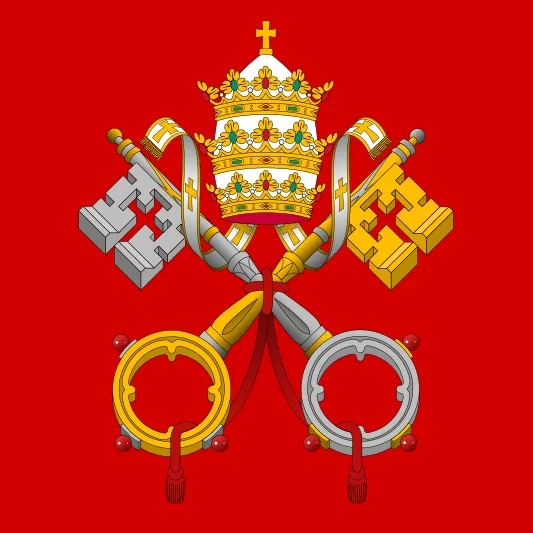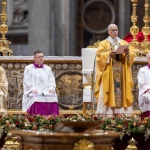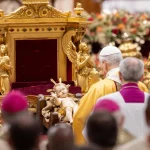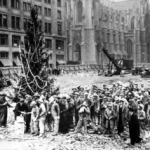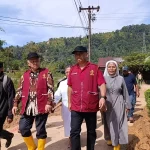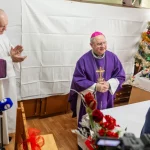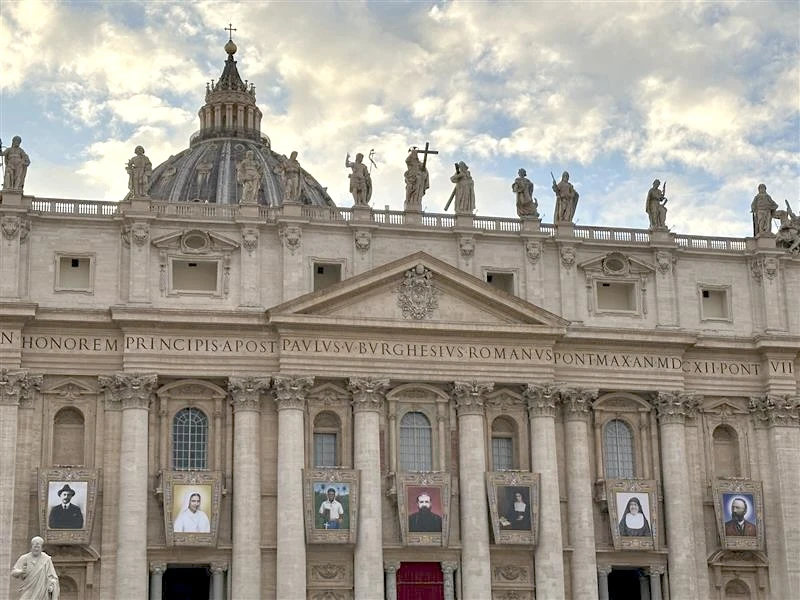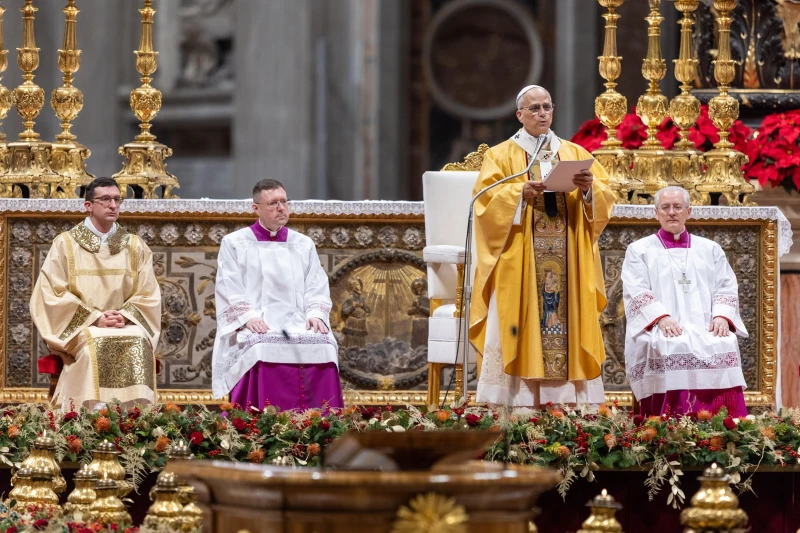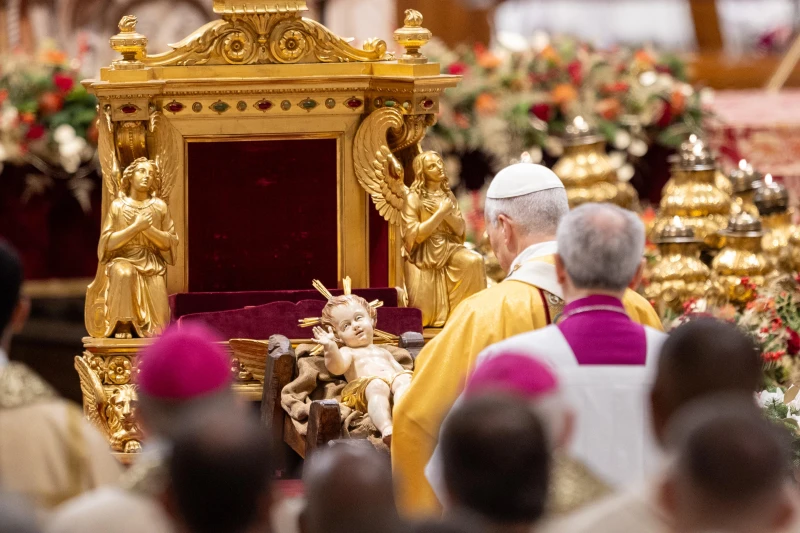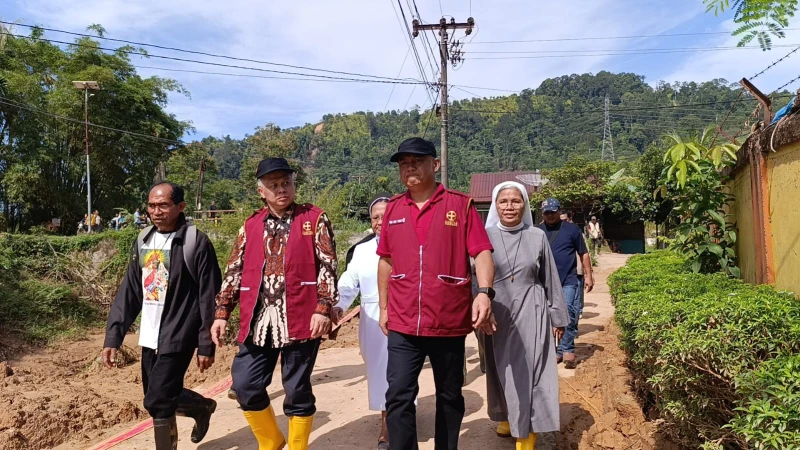
Pope Leo XIV will canonize seven new saints on Sunday including an Italian lawyer who renounced Satanism and became “an apostle of the Rosary,” a martyred Armenian archbishop, and a Venezuelan considered the “doctor of the poor.” Banners of the new saints are on display on St. Peter’s Basilica for all to see in St. Peter’s Square. / Credit: Courtney Mares / CNA
Vatican City, Oct 18, 2025 / 06:00 am (CNA).
Pope Leo XIV will canonize seven new saints on Sunday including an Italian lawyer who renounced Satanism and became “an apostle of the rosary,” a martyred Armenian archbishop, and a Venezuelan considered the “doctor of the poor.”
The canonizations, previously approved by the late Pope Francis, will be presided over by Pope Leo XIV on Oct. 19 at the Vatican. The group includes three women and four men, with two martyrs, three laypeople, and two founders of religious orders. Among them are Papua New Guinea’s first saint and the first two saints from Venezuela.
Let’s get to know these soon-to-be saints:

Bartolo Longo (1841–1926)
Bartolo Longo underwent one of the most dramatic conversions in recent Church history. He grew up in a Catholic household, but after studying law at a university in Naples, Italy, he went from being a practicing Catholic to taking part in anti-papal demonstrations to becoming an atheist, then a Satanist, and eventually being “ordained” to the Satanist priesthood.
Through the prayers of his family and the influence of devout friends, particularly Professor Vincenzo Pepe and Dominican priest Father Alberto Radente, Longo experienced a profound conversion, renouncing his past and returning wholeheartedly to the Catholic Church.
Following his conversion, Longo dedicated his life to promoting the rosary and the message of mercy and hope through the Virgin Mary. He settled in the poverty-stricken town of Pompeii where he began restoring a dilapidated church and tirelessly worked to build a Marian shrine dedicated to Our Lady of the Rosary. With support from benefactors and the local community, he transformed Pompeii into a thriving center of Catholic devotion. His efforts culminated in the construction of the Shrine of Our Lady of the Rosary of Pompeii, which continues to be a major pilgrimage site to this day.
In addition to his religious work, Longo was a tireless advocate for social justice. He founded schools, orphanages, and charitable institutions, especially for the children of prisoners, believing in the power of education and mercy to transform lives.
For the last 20 years of his life, Longo had constant health issues. He died on Oct. 5, 1926, and in 1980 was beatified by Pope John Paul II, who called him the “Apostle of the Rosary.”

Ignatius Choukrallah Maloyan (Ottoman Empire, 1869–1915)
Ignatius Maloyan was an Armenian Catholic archbishop of Mardin in the Ottoman Empire who was executed during the Armenian genocide for refusing to convert to Islam and renounce his Christian faith.
At the age of 14, Maloyan was sent to the convent of Bzommar-Lebanon. In 1896, he was ordained a priest in the Church of Bzommar convent and took the name Ignatius in honor of the beloved martyr of Antioch.
From 1892 to 1910, Maloyan was a parish priest in Alexandria and Cairo, where his good reputation was widespread. On Oct. 22, 1911, he was named archbishop of Mardin.
Soon after, the first World War broke out and Armenians in Turkey began to endure great suffering. On June 3, 1915, Turkish soldiers dragged Maloyan in chains to court with 27 other Armenian Catholic figures. During the trial, Mamdooh Bek, the chief of the police, asked Maloyan to convert to Islam. The archbishop answered that he would never betray Christ and his Church and was prepared to endure all types of punishments for his fidelity. He was imprisoned and frequently beaten.
On June 10, the Turkish soldiers gathered 447 Armenians and took them to a deserted area. During the ordeal, the archbishop encouraged those gathered to remain firm in their faith and prayed with them that they would accept martyrdom with courage.
After a two-hour walk, naked and chained, the prisoners were killed by the soldiers in front of Maloyan. Bek once again asked the archbishop to convert to Islam. He refused and was shot and killed by Bek on the feast of the Sacred Heart of Jesus.
Before he was killed, Maloyan said: “I consider the shedding of my blood for my faith to be the sweetest desire of my heart, because I know perfectly well that if I am tortured for the love of him who died for me, I will be among those who will have joy and bliss, and I will have obtained to see my Lord and my God up there.”
He was beatified by Pope John Paul II on Oct. 7, 2001.

Peter To Rot (Papua New Guinea, 1912–1945)
Peter To Rot, a lay catechist in Papua New Guinea, was martyred during the Japanese occupation in World War II. When the Catholic priest in his village was taken to a Japanese labor camp, the priest left To Rot in charge of catechizing the village and told him before he was taken: “Help them, so that they don’t forget about God.”
Despite Japanese oppression, To Rot worked in secret to keep the faith. He was a great defender of Christian marriage, working to defy Japanese law, which allowed men to take a second wife.
Toward the end of the war, the rules against religious freedom became even stricter, with any kind of prayer being forbidden. To Rot was arrested and sent to a manual labor camp in 1944 for his continual disobedience. In 1945 he was killed by lethal injection and is considered a martyr for the Catholic faith. He was beatified by Pope John Paul II on Jan. 17, 1995. He will be Papua New Guinea’s first saint.

José Gregorio Hernández (Venezuela, 1864–1919)
José Gregorio Hernández, a Venezuelan physician, scientist, and layman, is revered as the “doctor of the poor.”
Born on Oct. 26, 1864, in Isnotú in the Venezuelan state of Trujillo, he lost his mother at the age of 8.
He studied medicine in Caracas and received government funding to continue his studies in Paris in 1889 for two years. After returning to Venezuela, he became a professor at the Central University of Caracas, where he started each lesson with the sign of the cross.
Hernández attended daily Mass, brought medicine and care to the poor, and made a profession as a Third Order Franciscan. In 1908 he gave up his profession and entered a cloistered Carthusian monastery in Farneta, Italy. However, nine months later he fell ill and his superior ordered him to return to Venezuela to recover.
After some time, Hernández concluded that it was God’s will for him to remain a layman. He decided then to promote sanctification as an exemplary Catholic by being a doctor and giving glory to God by serving the sick. He devoted himself to academic research and deepened his dedication to serving the poor.
One day, as the doctor went to pick up medicine for an elderly poor woman, he was hit by a car. He died in the hospital on June 29, 1919. He was beatified by Pope Francis on April 30, 2021.

Maria Troncatti (Italy/Ecuador, 1883–1969)
Maria Troncatti, an Italian Salesian sister, spent nearly five decades as a missionary in Ecuador’s Amazon rainforest among the Indigenous Shuar people.
Growing up in Italy, Troncatti showed an interest in religious life from a young age. She made her first profession as part of the Daughters of Mary Help of Christians, also known as the Salesian Sisters of Don Bosco, in 1908.
During World War I, Sister Maria trained in health care and worked as a Red Cross nurse in a military hospital. In 1925 she began her mission serving the Shuar Indians in the Amazon forest in the southeastern part of Ecuador. For 44 years, she was known as “Madrecita,” or “little mother,” by everyone in the village. Not only did she serve as a surgeon, dentist, nurse, orthopedist, and anesthesiologist, she was also a faithful catechist sharing the Gospel with all those she served.
Sister Maria died at the age of 86 on Aug. 25, 1969, in a plane crash. She was beatified by Pope Benedict XVI in 2012.

María del Carmen Rendiles Martínez (Venezuela, 1903–1977)
Carmen Elena Rendiles Martínez was born in Caracas, Venezuela, without her left arm and was given a prosthetic arm that she used for her entire life.
In 1918, Martínez began to feel a call to religious life, but having a disability was considered a reason for rejection from some religious congregations at that time. Eventually, she joined the Servants of the Eucharist in 1927 and took the name María Carmen. She once said: “I want to be holy. I want to say like St. Paul: It is no longer I who live, but Christ who lives in me.”
When her religious community sought autonomy from its French motherhouse in 1965, she went on to found the Servants of Jesus in Caracas to continue its mission of Eucharistic devotion. She served as the superior general of the congregation from 1969 when she was appointed until her death in 1977 from influenza.
She was beatified by Pope Francis in 2018 and will become Venezuela’s first female saint.

Vincenza Maria Poloni (Italy, 1802–1855)
Vincenza Maria Poloni, an Italian religious sister, founded the Congregation of the Sisters of Mercy of Verona to care for the poor, sick, and elderly.
Born the youngest of 12 siblings, she discerned her vocation under the guidance of Blessed Charles Steeb as she devoted her time to working with the poor, the elderly, and chronically ill.
In 1836, during the cholera epidemic of 1836, she worked tirelessly in the emergency wards, putting her own health at risk. In 1840 she devoted herself full time to the care of the sick and elderly and began to live a similar lifestyle to that of a religious sister — fervent prayer, strict schedules, and total service of charity toward others.
On Sept. 10, 1848, Poloni founded the Sisters of Mercy of Verona and took the name Vincenza Maria. Her motto, “Serving Christ in the Poor,” became the foundation of her congregation, which can be found today on three continents. She died on Nov. 11, 1855, from a tumor that had spread throughout her body. She was beatified in 2008.

